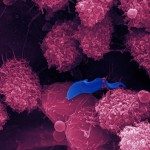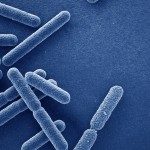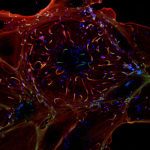The time to start a project is flexible.
We offer several projects intended for M1 and M2 students in physics, biology, chemistry, or engineering from Paris, France, or European countries, who want to work at the interface of physics and biology using novel quantitative methods. The projects can lead to a subsequent PhD position. The exact start date is flexible. All projects available involve single-cell microscopy and computational image analysis and thus require a solid basic knowledge of programming, physics, and math.
Some of the projects the students can be involved in are:
1) Bacterial morphogenesis during cell elongation and cell division
We measure bacterial cell shape of different bacteria during growth and division with high precision. We then correlate cell-shape deformations with the dynamics and localization of important cell-shape regulating proteins that we monitor by high-resolution fluorescence microscopy, in order to identify molecular determinants of cell shape [1,5]. Depending on the candidate’s background the project is complemented by genetics and molecular biology or mechanical perturbations [2] and computational modeling.
2) Cell-cycle regulation
In this project we monitor bacterial growth during the cell cycle and different physiological processes required for proper cell-cycle completion on the single-cell level. The experiments inform stochastic models of growth-rate control that we are developing together with Marco Cosentino-Lagomarsino (UPMC). This project requires careful microscopy and image analysis. The project can also include computational/theoretical work.
3) Bacterial biofilms
In collaboration with the Kolodkin-Gal lab (Weizmann Institute, Rehovot, Israel) and the Lipfert lab (LMU Munich, Germany) we study the importance of extracellular protein fibers for bacterial biofilms [3]. We are particularly interested in fiber assembly and attachment to the cell envelope. We also measure and exert forces onto the fibers in order to measure their role as force sensors and their role in signaling. See Master-project-biofilms2016 for more information.
3) RNA localization
In collaboration with Michele Castellana (Institut Curie) we study the effect of RNA localization on translation efficiency. A recent theory by Michele predicts the mutual dependency of chromosome compaction, RNA and ribosome localization. We will synthetically alter native RNA localization to test its effect on translation. We monitor localization and efficiency by fluorescence microscopy, using fluorescent proteins to label RNAs and as a reporter for translation. More information can be found here.
The exact project and methods used will depend on the preferences and educational background of the student.
For questions contact me by email: sven[at]pasteur[dot]fr. For applications, please send by email (IN ENGLISH) a cover letter including a short motivation of why you would like to work in our lab, and your CV.
Bibliography
- Ursell, T. S., et al. (2014) Rod-like bacterial shape is maintained by feedback between cell curvature and cytoskeletal localization. Nat. Acad. Sci. U.S.A., 111(11), E1025-E1034.
- Amir, A., et al. (2014) Bending forces plastically deform growing bacterial cell walls. PNAS, 111(16), 5778.
- Kolodkin-Gal, I., et al. (2010) D-amino acids trigger biofilm disassembly. Science, 328(5978), 627.
- Drescher, K., Dunkel, J., Nadell, C. D., van Teeffelen, S., Grnja, I., Wingreen, N. S., … & Bassler, B. L. (2016). Architectural transitions in Vibrio cholerae biofilms at single-cell resolution. Nat. Acad. Sci. U.S.A.113(14), E2066-E2072.
- Amir, A., S. van Teeffelen*. (2014) Getting into shape: How do rod-like bacteria control their geometry?. Systems and synthetic biology 8: 227-35.
- van Teeffelen, S.*, Achim, C. V., and Löwen, H.. (2013) Vacancy diffusion in colloidal crystals as determined by dynamical density-functional theory and the phase-field-crystal model. Rev. E 87: 022306.
- van Teeffelen, S.*, J. W. Shaevitz, and Z. Gitai. (2012) Image analysis in fluorescence microscopy: Bacterial dynamics as a case study. Bioessays 34: 427-36.
- van Teeffelen, S.*, S. Wang, L. Furchtgott, K. C. Huang, N. S. Wingreen, J. W. Shaevitz, and Z. Gitai. (2011) The bacterial actin MreB rotates, and rotation depends on cell-wall assembly. Nat. Acad. Sci. U.S.A. 108: 15822-7.


